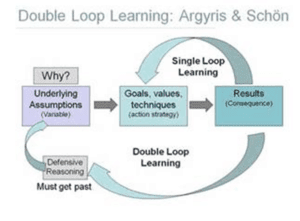Conflict or Problem and the Learning Organization
What is the meaning of conflict and problem?
Let us start our discussion today with a few definitions of the words “Conflict” and “Problem”. There are so many definitions and we needed a common starting point to allow for an informative discourse.
Conflict is defined by Merriam-Webster as:
“A struggle for power, property, etc., strong disagreement between people, groups, etc., that results in often angry argument, and a difference that prevents agreement: disagreement between ideas, feelings, etc.” (Merriam-Webster “Conflict”)
The book Creative Approaches to Problem Solving describes a Conflict as:
“This factor deals with the presence of personal and emotional tension in the organization, and it is the only dimension that does not contribute positively to creativity.” (Isaksen, Treffinger, & Dorval, 2011)(pg.189)
Problem is defined by Merriam-Webster as:
“Something that is difficult to deal with: something that is a source of trouble, worry, etc., difficulty understanding something, and a feeling of not liking or wanting to do something.” (Merriam-Webster “Problem”)
The book Creative Approaches to Problem Solving describes Problem Solving as:
“A process of closing the gap between what is and what is desired”. (Isaksen, Treffinger, & Dorval, 2011)(pg.19)
Problems can produce conflict
From the definitions above, we can draw a simple conclusion that conflicts have an emotional overtone and a problem is merely the tension between an actual situation and the desired situation or end state. Having said that we can also conclude that conflicts rarely just arise, they usually start as a problem and become a conflict due to the manner in which they were (or not) resolved. Also, knowing that we cannot devoid ourselves from emotion, some problems will inevitably become conflicts solely due to their nature or may seem to be a conflict due to the initial emotional response by one if not all parties.
The Learning Organization’s Approach
A learning organization will view a problem or conflict as an opportunity to analyze or analyze its’ perspective of their current position or state against the desire position or state. Several of our previous discussions have touched on the topic of perspectives. We have shown how this influences the direction of an organization. This continual evaluation by the organization of itself is an example of the theory of double loop learning by Chris Arygris and Schon.
(Schon & Argyris)
We have briefly discussed why problems and conflicts can be seen as beneficial. Now we can look into ways a learning organization would help in handling them. To do this effectively we must remember both problems and conflicts provide us an opportunity for growth and development.
Not all problems or conflicts can be solved amicably. If we approach a problem with an open mental model, the possibility of inadvertently escalating to a conflict is reduced. The premise of the mental model is continual evaluation of our perspective of the actual state of our organization and us. To do this we must create an environment that allows others to share their perspective(s). This does not mean that we are required to agree with them, but we should analyze what they are offering. It is not enough that we listen to their perspective, but we must understand the why(s) behind them.
This will aid us in our systems thinking as it will afford us the opportunity to see the system interrelations from another’s perspective. This seeking to understand another individual’s perspective creates a positive experience for both parties. In our discussion of the leadership equation, we saw how providing a positive experience has a dramatic effect on individual behavior. The effect of providing an individual with positive experiences should decrease the emotional aspect of newly developing issues and help them feel a sense of shared vision; another L.O. principal. Additionally, having a shared vision will promote ownership of problems, which will in turn promote the individual to seek a solution that betters the entire system. This will demote conflicts to the problem level through the lessening of the personal emotional aspects of a conflict. The reduction of the emotional aspect will then in turn afford an easier dialogue between parties thus starting the cycle at a better state in future instances.
Summary
While all of this makes conflict resolution and problem solving sound simple we all know there is more to this topic. However, this discussion merely focuses on how conflicts and problems; when handled using some of the principals of a learning organization, can provide growth for both the individual and the organization. In later discussions, we will address other aspects of opportunities presented by conflicts and problems when handled through learning organizational.
Isaksen, S. G., Treffinger, D. J., & Dorval, K. B. (2011). Creative Approaches to Problem Solving, A Framework for Innovation and Change. In S. G. Isaksen, D. J. Treffinger, & K. B. Dorval, Creative Approaches to Problem Solving, A Framework for Innovation and Change (p. 291). Los Angeles, CA.: Sage.
Merriam-Webster “Conflict”. (n.d.). Retrieved August 4, 2014, from Merriam-Webster: http://www.merriam-webster.com/dictionary/conflict
Merriam-Webster “Problem”. (n.d.). Retrieved August 4, 2014, from Merriam-Webster: http://www.merriam-webster.com/dictionary/problem
Schon, & Argyris, C. (n.d.). Double Loop Learning. Retrieved August 4, 2014, from Double Loop Learning: Argyris & Schon: http://www.bing.com/images/search?q=Chris+Argyris+Double+Loop+Learning&id=44F8E7DD42D0C94DF3F52E51898C42E774B2F2E9&FORM=IQFRBA#view=detail&id=6F1F75DD9AA201AE5E24E235AE071583E7736951&selectedIndex=3

